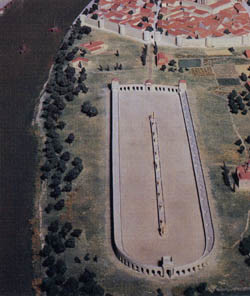The Roman circus
Historic site and monumentPresentation
Date: 149
Period: Antiquity
Type : Public leisure architecture
Status : Property of the City of Arles Classified as a historic monument (1992)
Period: Antiquity
Type : Public leisure architecture
Status : Property of the City of Arles Classified as a historic monument (1992)
The largest Roman monument, the circus, could only be built outside the city. It was built to the southwest of the city, on the banks of the Rhône, in the 2nd century. It was mainly used for horse and chariot racing, but also for occasional cavalry battles and venationes, a kind of hound hunt. Its construction can hardly have been easy. Given the unstable nature of the terrain, it had to be built on thousands of wooden piles. Few of its materials and decorations remain, having been dispersed at the end of the Empire. Some have been reused, and a few are on display at the Musée Départemental Arles Antique. Its most sumptuous ornament, however, is the obelisk installed in the 17th century in front of the town hall. The Arles circus was 450 meters long and 101 meters wide. It featured tiered seating for 20,000 spectators, and a vast groomed arena with a long central divider, the spina ("thorn"). The spina, decorated with sculptures and basins, ended at both ends with bollards (or metae), which competitors tried to pass as closely as possible. The track was surrounded by a wall (the podium), high enough to protect the spectators. The bleachers were based on a modular architectural structure of chambers closed by rampant vaults, not unlike that of an amphitheatre.
Due to the instability of the clay soil, skilful foundations were required. They consisted of 30,000 wooden piles 2 to 3.50 m long. Today, the only remains visible below the museum are the remains of the substructure of the cavea (terraces) and the exterior of the spendone, the rounded part of the circus. The Roman circus at Arles was built in 149 AD, representing the largest urban extension of the period.
This date shows that Flavian developments continued right up to the time of Emperor Antoninus the Pious, at the height of the Empire.
The edifice underwent a drastic overhaul in the 4th century. Excavations showed that the spina had been partly destroyed and then restructured with new marble veneer decoration and an obelisk. Small dwellings appeared around the circus and in the alveoli in the 5th century, when races were still held. In the middle of the 6th century, the monument was destroyed when its stones were needed to reinforce the city walls.
Flooding of the Rhône soon covered the site with alluvium, and the remains of the circus were only unearthed in the 17th and 19th centuries, before being excavated in greater depth in the 20th century.
Due to the instability of the clay soil, skilful foundations were required. They consisted of 30,000 wooden piles 2 to 3.50 m long. Today, the only remains visible below the museum are the remains of the substructure of the cavea (terraces) and the exterior of the spendone, the rounded part of the circus. The Roman circus at Arles was built in 149 AD, representing the largest urban extension of the period.
This date shows that Flavian developments continued right up to the time of Emperor Antoninus the Pious, at the height of the Empire.
The edifice underwent a drastic overhaul in the 4th century. Excavations showed that the spina had been partly destroyed and then restructured with new marble veneer decoration and an obelisk. Small dwellings appeared around the circus and in the alveoli in the 5th century, when races were still held. In the middle of the 6th century, the monument was destroyed when its stones were needed to reinforce the city walls.
Flooding of the Rhône soon covered the site with alluvium, and the remains of the circus were only unearthed in the 17th and 19th centuries, before being excavated in greater depth in the 20th century.
General information
- Style :
- Ancient
- Park :
- Camargue Regional Nature Park
Services, Tours, Activities and entertainment
- Historical patrimony :
- Historic patrimony
- Ruins and remains
Contact
The Roman circus
Presqu'ile du cirque romain
13200
Arles
Phone : +33 4 90 18 41 20

Destination
Le cirque romain
Presqu'ile du cirque romain
13200
Arles
GPS coordinates
Latitude : 43.672714
Longitude : 4.61679



